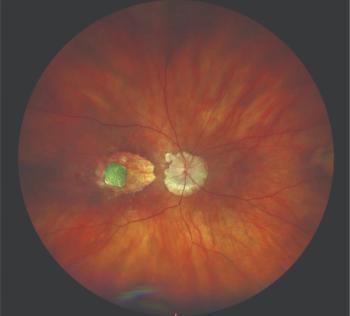
Study: Elevated NLR and SII levels linked to higher risk of cystoid macular edema
Key Takeaways
- Elevated NLR and SII levels are significantly associated with cystoid macular edema in diabetic macular edema patients.
- The study involved 50 eyes from 37 treatment-naïve patients, divided into CME and DRT groups, with a control group.
Researchers conducted a retrospective study to assess serum inflammatory biomarkers in patients with different subtypes of diabetic macular edema (DME).
The results of a recent study indicated that elevated neutrophil-to-lymphocyte ratio (NLR) and systemic immune-inflammation index (SII) levels may be associated significantly with cystoid macular edema (CME). The elevated levels may indicate a higher incidence of CME in these patients,1 according to researchers from the Department of Ophthalmology, Shantou University Medical College North Guangdong People’s Hospital, Guangdong, China. First author Wu Liao led the study published in International Ophthalmology.
The researchers conducted a retrospective study to assess serum inflammatory biomarkers in patients with different subtypes of
A total of 50 eyes of 37 treatment-naïve patients with DME were included in the study. All had received intravitreal injection therapy and
The patients were then divided into 1 of 2 groups based on the imaging findings: 25 patients in the group with CME and 25 in the group with diffuse retinal thickening (DRT). The study also included a control group comprised of 25 eyes with diabetic retinopathy without DME.
The investigators reviewed the best-corrected visual acuity (BCVA), central macular thickness (CMT), macular cube volume (VOL) and hematologic examination. The NLR, platelet-to-lymphocyte ratio (PLR), and SII were calculated, they recounted.
Analysis results
The investigators reported significantly higher NLR and SII levels in the CME group compared to the DRT and control groups (P < 0.01 for all comparisons).
Specifically, the optimal receiver operating characteristic (ROC) curve cutoff value of the NLR for CME was 2.27, with 88.0% sensitivity and 68.0% specificity. The optimal ROC cutoff value of SII for CME was 447.33, with 84.0% sensitivity and 60.0% specificity, they reported.
After the patients underwent an intravitreal injection, the BCVA and VOL significantly improved in each group (P < 0.01 for all comparisons), but they did not find a significant correlation between the levels of the systemic inflammatory markers and the postoperative changes in BCVA, CMT, and VOL (P > 0.05 for all comparisons).
Based on the results, the authors concluded that the CME was correlated significantly with the elevated NLR and SII levels, which may indicate a higher incidence of CME in these patients.
Reference
Liao W, Liu F, Liu W, et al. Serum inflammation biomarkers level in cystoid and diffuse diabetic macular edema. Int Ophthalmol. 2024;44:447; https://doi.org/10.1007/s10792-024-03372-7
Newsletter
Don’t miss out—get Ophthalmology Times updates on the latest clinical advancements and expert interviews, straight to your inbox.





